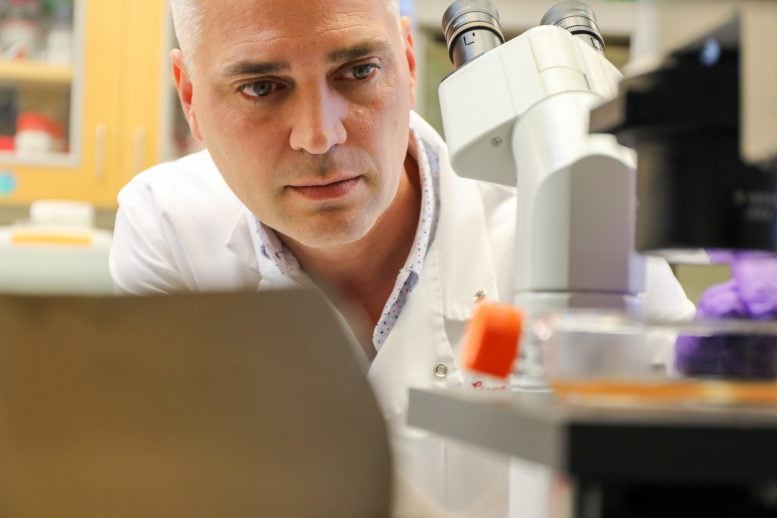Researchers at Oregon Health & Science University have successfully tested a potential universal flu vaccine, using the 1918 flu virus to generate a lasting immune response in primates against the evolving H5N1 virus, paving the way for a single-shot influenza vaccine.
OHSU-led research develops innovative vaccine platform targeting virus interior; scientists validate theory with 1918 flu virus
New findings from a study conducted by Oregon Health & Science University present a hopeful method for creating a universal flu vaccine. This “one and done” vaccine could provide lifelong protection against a constantly changing 
Jonah Sacha, Ph.D., senior co-author of a study published in the journal Nature Communications, says the research could lead to a universal influenza vaccine within five years. Credit: OHSU/Christine Torres Hicks
“The problem with influenza is that it’s not just one virus,” Sacha said. “Like the SARS-CoV-2 virus, it’s always evolving the next variant and we’re always left to chase where the virus was, not where it’s going to be.”
The spike proteins on the virus exterior surface evolve to elude antibodies. In the case of flu, vaccines are updated regularly using a best estimate of the next evolution of the virus. Sometimes it’s accurate, sometimes less so.
In contrast, a specific type of T cell in the lungs, known as effector memory T cell, targets the internal structural proteins of the virus, rather than its continually mutating outer envelope. This internal structure doesn’t change much over time — presenting a stationary target for T cells to search out and destroy any cells infected by an old or newly evolved influenza virus.
Success with a century-old template
To test their T cell theory, researchers designed a CMV-based vaccine using the 1918 influenza virus as a template. Working within a highly secure biosafety level 3 laboratory at the University of Pittsburgh, they exposed the vaccinated nonhuman primates to small particle aerosols containing the avian H5N1 influenza virus — an especially severe virus that is currently circulating among dairy cows in the United States.
Remarkably, six of the 11 vaccinated primates survived the exposure, despite the century-long period of virus evolution.
“It worked because the interior protein of the virus was so well preserved,” Sacha said. “So much so, that even after almost 100 years of evolution, the virus can’t change those critically important parts of itself.”
The study raises the potential for developing a protective vaccine against H5N1 in people.
“Inhalation of aerosolized H5N1 influenza virus causes a cascade of events that can trigger respiratory failure,” said co-senior author Simon Barratt-Boyes, Ph.D., professor of infectious diseases, microbiology and immunology at Pitt. “The immunity induced by the vaccine was sufficient to limit virus infection and lung damage, protecting the monkeys from this very serious infection.”
By synthesizing more up-to-date virus templates, the new study suggests CMV vaccines may be able to generate an effective, long-lasting immune response against a wide suite of new variants.
“I think it means within five to 10 years, a one-and-done shot for influenza is realistic,” Sacha said.
The same CMV platform developed by OHSU researchers has advanced to a clinical trial to protect against HIV, and a recent publication by those scientists suggests it may even be useful in targeting specific cancer cells. The HIV clinical trial is being led by Vir Biotechnology, which licensed the vaccine platform from OHSU.
Sacha sees the development as the latest in the rapid advance of medical research to treat or prevent disease.
“It’s a massive sea change within our lifetimes,” Sacha said. “There is no question we are on the cusp of the next generation of how we address infectious disease.”
Reference: “Cytomegalovirus vaccine vector-induced effector memory CD4 + T cells protect cynomolgus macaques from lethal aerosolized heterologous avian influenza challenge” by Daniel Malouli, Meenakshi Tiwary, Roxanne M. Gilbride, David W. Morrow, Colette M. Hughes, Andrea Selseth, Toni Penney, Priscila Castanha, Megan Wallace, Yulia Yeung, Morgan Midgett, Connor Williams, Jason Reed, Yun Yu, Lina Gao, Gabin Yun, Luke Treaster, Amanda Laughlin, Jeneveve Lundy, Jennifer Tisoncik-Go, Leanne S. Whitmore, Pyone P. Aye, Faith Schiro, Jason P. Dufour, Courtney R. Papen, Husam Taher, Louis J. Picker, Klaus Früh, Michael Gale Jr, Nicholas J. Maness, Scott G. Hansen, Simon Barratt-Boyes, Douglas S. Reed and Jonah B. Sacha, 19 July 2024, Nature Communications.
DOI: 10.1038/s41467-024-50345-6
In addition to OHSU, research institutions involved in the study included the Tulane National Primate Research Center, the University of Pittsburgh, the





















Discussion about this post